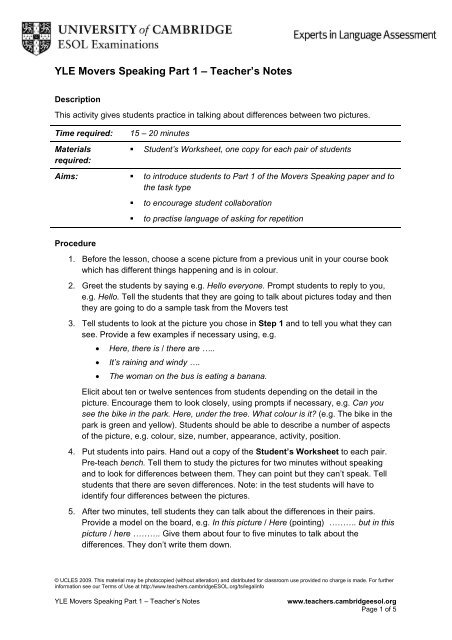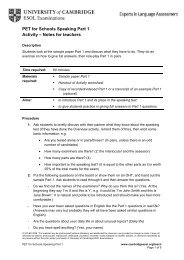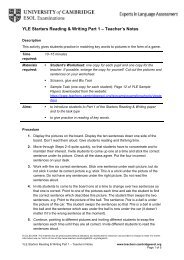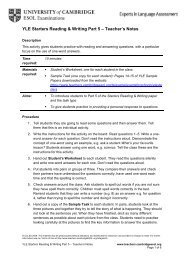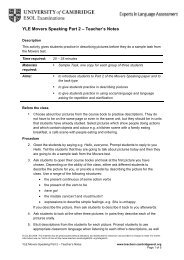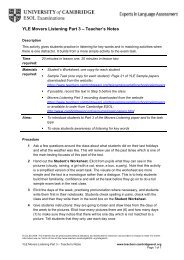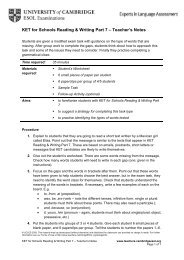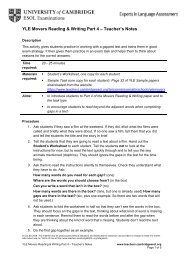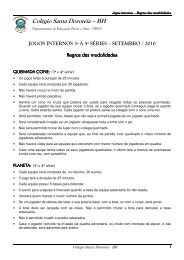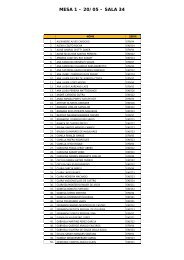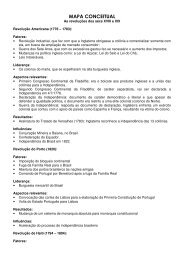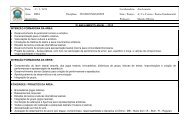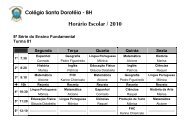YLE Movers Speaking Part 1 â Teacher's Notes
YLE Movers Speaking Part 1 â Teacher's Notes
YLE Movers Speaking Part 1 â Teacher's Notes
You also want an ePaper? Increase the reach of your titles
YUMPU automatically turns print PDFs into web optimized ePapers that Google loves.
<strong>YLE</strong> <strong>Movers</strong> <strong>Speaking</strong> <strong>Part</strong> 1 – Teacher’s <strong>Notes</strong><br />
Description<br />
This activity gives students practice in talking about differences between two pictures.<br />
Time required:<br />
Materials<br />
required:<br />
15 – 20 minutes<br />
• Student’s Worksheet, one copy for each pair of students<br />
Aims: • to introduce students to <strong>Part</strong> 1 of the <strong>Movers</strong> <strong>Speaking</strong> paper and to<br />
the task type<br />
• to encourage student collaboration<br />
• to practise language of asking for repetition<br />
Procedure<br />
1. Before the lesson, choose a scene picture from a previous unit in your course book<br />
which has different things happening and is in colour.<br />
2. Greet the students by saying e.g. Hello everyone. Prompt students to reply to you,<br />
e.g. Hello. Tell the students that they are going to talk about pictures today and then<br />
they are going to do a sample task from the <strong>Movers</strong> test<br />
3. Tell students to look at the picture you chose in Step 1 and to tell you what they can<br />
see. Provide a few examples if necessary using, e.g.<br />
• Here, there is / there are …..<br />
• It’s raining and windy ….<br />
• The woman on the bus is eating a banana.<br />
Elicit about ten or twelve sentences from students depending on the detail in the<br />
picture. Encourage them to look closely, using prompts if necessary, e.g. Can you<br />
see the bike in the park. Here, under the tree. What colour is it? (e.g. The bike in the<br />
park is green and yellow). Students should be able to describe a number of aspects<br />
of the picture, e.g. colour, size, number, appearance, activity, position.<br />
4. Put students into pairs. Hand out a copy of the Student’s Worksheet to each pair.<br />
Pre-teach bench. Tell them to study the pictures for two minutes without speaking<br />
and to look for differences between them. They can point but they can’t speak. Tell<br />
students that there are seven differences. Note: in the test students will have to<br />
identify four differences between the pictures.<br />
5. After two minutes, tell students they can talk about the differences in their pairs.<br />
Provide a model on the board, e.g. In this picture / Here (pointing) ………. but in this<br />
picture / here ………. Give them about four to five minutes to talk about the<br />
differences. They don’t write them down.<br />
© UCLES 2009. This material may be photocopied (without alteration) and distributed for classroom use provided no charge is made. For further<br />
information see our Terms of Use at http://www.teachers.cambridgeESOL.org/ts/legalinfo<br />
<strong>YLE</strong> <strong>Movers</strong> <strong>Speaking</strong> <strong>Part</strong> 1 – Teacher’s <strong>Notes</strong><br />
www.teachers.cambridgeesol.org<br />
Page 1 of 5
6. Elicit the differences from different pairs. Prompt students to use appropriate<br />
classroom language when listening to each other, e.g. I don’t understand. Can you<br />
repeat, please? Again, please? Sorry?<br />
7. Stress to students that there is more than one way of talking about the differences<br />
e.g.<br />
• The boy’s eating a sandwich in this picture but in this one he’s eating some<br />
chips.<br />
• Here he’s eating sandwich. Here he’s eating chips.<br />
• Here sandwich, here chips.<br />
Simple language is acceptable though you should encourage students to say more if<br />
they can.<br />
8. At the end of the activity, elicit the following from students:<br />
• What should you say to the examiner at the start of the test? (Hello. You<br />
may also want to establish now that there will be one examiner and one child<br />
in the test, i.e. they will not do the test with a partner.)<br />
• How many pictures will you compare in <strong>Part</strong> 1 of the test? (two)<br />
• How many differences do you have to find? (four)<br />
• Do you have to give full sentences? (no, you can point to a picture and say<br />
e.g. Here …. as well as use longer sentences e.g. In this picture …)<br />
• What should you say if you don’t understand? (e.g. I don’t understand.<br />
Can you repeat, please? Again, please? Sorry? This shows good knowledge<br />
of English.)<br />
Suggested follow-up activities<br />
1. Students write the differences in their notebooks using the model you gave them in<br />
Step 4.<br />
2. The activity described in Steps 1–3 is a useful activity to do with the class on a<br />
regular basis to get students used to describing and comparing pictures.<br />
Additional information<br />
There are three aspects that are assessed in the <strong>Movers</strong> <strong>Speaking</strong> Test:<br />
• Reception – listening and interaction<br />
• Production – appropriacy, promptness and extent of response<br />
• Production – pronunciation .<br />
Each criterion carries a maximum mark of 3.<br />
In the Test, each student is taken into the examination room by an usher. The usher is<br />
someone who speaks the student’s first language and who is possibly known to the student<br />
© UCLES 2009. This material may be photocopied (without alteration) and distributed for classroom use provided no charge is made. For further<br />
information see our Terms of Use at http://www.teachers.cambridgeESOL.org/ts/legalinfo<br />
<strong>YLE</strong> <strong>Movers</strong> <strong>Speaking</strong> <strong>Part</strong> 1 – Teacher’s <strong>Notes</strong><br />
www.teachers.cambridgeesol.org<br />
Page 2 of 5
e.g. a teacher. The usher explains the test format in the student’s mother tongue, before<br />
taking the student into the examination room and introducing him/her to the examiner.<br />
<strong>Movers</strong> is aimed at students who have some experience of speaking English and probably<br />
also have some experience of test situations. <strong>Movers</strong> builds on the foundations laid at<br />
Starters level by asking the students to give more extended responses (e.g. describing a<br />
picture) as well as showing their comprehension of what the examiner says. Candidates<br />
may be asked questions such as 'Where do you go after school?' or 'Tell me about your<br />
favourite sport.'<br />
At this level, candidates are expected to answer with greater expansion than at Starters<br />
level, and to answer reasonably promptly, although they are not penalised for taking their<br />
time to think in tasks such as Tell the Story or Find the Odd-one-out.<br />
© UCLES 2009. This material may be photocopied (without alteration) and distributed for classroom use provided no charge is made. For further<br />
information see our Terms of Use at http://www.teachers.cambridgeESOL.org/ts/legalinfo<br />
<strong>YLE</strong> <strong>Movers</strong> <strong>Speaking</strong> <strong>Part</strong> 1 – Teacher’s <strong>Notes</strong><br />
www.teachers.cambridgeesol.org<br />
Page 3 of 5
<strong>YLE</strong> <strong>Movers</strong> <strong>Speaking</strong> <strong>Part</strong> 1 – Answer Keys<br />
Key to Procedure step 5<br />
Possible answers:<br />
• In this picture it’s cloudy. In this picture it’s sunny.<br />
• The coat in here is red. There, it’s yellow.<br />
• The boy’s eating a sandwich here. In that picture he’s eating some chips.<br />
• In this picture there’s a blue bird sitting next to the boy. In this picture, there’s a<br />
brown and white cat sitting next to the boy.<br />
• The boy is eating with both hands here. There he’s eating with one hand and holding<br />
his chips with the other.<br />
• Here, the toy monster on the bench next to the boy has got three legs. Here it’s got<br />
four legs.<br />
• Here, the sky is grey. Here, it’s blue.<br />
© UCLES 2009. This material may be photocopied (without alteration) and distributed for classroom use provided no charge is made. For further<br />
information see our Terms of Use at http://www.teachers.cambridgeESOL.org/ts/legalinfo<br />
<strong>YLE</strong> <strong>Movers</strong> <strong>Speaking</strong> <strong>Part</strong> 1 – Answer Keys<br />
www.teachers.cambridgeesol.org<br />
Page 4 of 5
<strong>YLE</strong> <strong>Movers</strong> <strong>Speaking</strong> <strong>Part</strong> 1 – Student’s Worksheet<br />
Look at the two pictures.<br />
How many differences can you find?<br />
© UCLES 2009. This material may be photocopied (without alteration) and distributed for classroom use provided no charge is made. For further<br />
information see our Terms of Use at http://www.teachers.cambridgeESOL.org/ts/legalinfo<br />
<strong>YLE</strong> <strong>Movers</strong> <strong>Speaking</strong> <strong>Part</strong> 1 – Student’s Worksheet<br />
www.teachers.cambridgeesol.org<br />
Page 5 of 5


